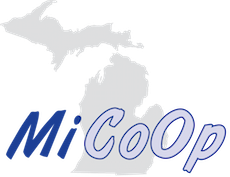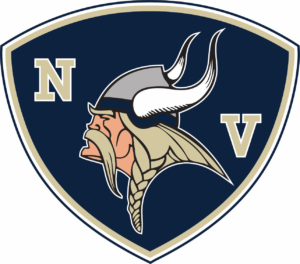 Dynamic Learners | Diverse Opportunities | Driven to Succeed
Dynamic Learners | Diverse Opportunities | Driven to Succeed
In the southwest corner of the state, just five miles from the Indiana border, Niles Community Schools (NCS) provides diverse learning opportunities to roughly 3,500 students. Options include comprehensive K-12 programming, an alternative school, a virtual school, WAY and WAY Forward programs, a Montessori early childhood program, Kinder Connections, two center-based programs for special needs students, and an adult education program. Programs are delivered at the Northside Child Development Center, in two elementary schools, a K-8 project-based school, a middle school, a high school, and the administration building.
According to mischooldata.org, 60% of students enrolled in Niles are economically disadvantaged and 15% have disabilities. Two-thirds of the student body is white while the remaining third is almost equally shared by Hispanic/Latino, African American, and two or more races. More students choose to enroll in the district through school of choice than leave the district for another school. Regardless of economic status, demographics, or geographic location, Niles Community Schools focuses on creating options for students to succeed.
This article highlights the diverse opportunities Niles Community Schools offers their students to personalize their learning and find success in their educational journey.
Opportunities for Success in the Early Years
Options for students just beginning school include the Montessori program (3-, 4-, and 5-year olds), Kinder Connections, Ballard Elementary, Howard-Ellis Elementary, and Eastside Connections School. Staff help parents decide which program is best for their child using a kindergarten screener that measures academic, social, and emotional readiness. Additional information shared by the parents is also a factor in determining the best fit.
Kinder Connections began in 2016 for students who are of school age but not yet ready for kindergarten. Teachers and instructional assistants work with students through a school readiness curriculum so when they retake the kindergarten screener at the end of the year, Kinder Connections staff can show parents the growth their children made over the year. As these students move on to kindergarten, they have stronger academic, social, and emotional skills and many become leaders in their kindergarten class. Three sections of the program are offered each year, meeting the needs of 60 students.
The district is intentional about connecting with their elementary students throughout the summer to keep learning on track. Summer My Way is a program, in partnership with the local YMCA, for K-5 students. This all-day, six-week program is held at Niles’ Northside Child Development Center building. In two-week blocks, students explore interests and careers. While the options may vary from year to year, in most years, they can choose from coding, sports, drawing, and clay. At-risk students are encouraged to apply and scholarships are available. Throughout the summer, middle school student mentors and community members assist the 200 students who enroll in this program.
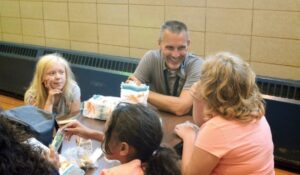
PC: Leader Publications, KELSEY HAMMON
Another summer K-5 program is their Pop-Up Libraries. Niles combines this literacy program with their Meet Up and Eat Up program and the support from a United Way grant. When families come to Meet Up and Eat Up for lunch, the children also receive a book whether they are in the program or not (e.g., siblings, cousins, friends). High school students and volunteers help students pick out books based on the child’s reading level. Students can be found reading their book while eating lunch and many take them home. Six to eight pop-up libraries are offered throughout the summer.
In conjunction with the pop-up libraries, Niles also conducts Book Fairy home visits. For students who are recommended to attend one of the summer programs and may be unable to attend or were absent, a team of elementary teachers personally deliver books to the students’ home. Prior to visiting, the teacher calls the parents to find out the child’s interests. Then during the 15-minute home visits, they give two appropriate-level books to the child as close to those topics as possible. They also bring books for other children in the home as well as materials for parents about the importance of reading. These additional connections throughout the summer are helping their elementary students continue to grow in their learning.
K-8 Problem Solvers
Eastside Connections School (ECS) serves K-8 students looking for a more personalized learning path. Joe Racht became the principal at ECS in 2014, three years after the school opened. This school of choice does not offer bussing and parents must volunteer time in the building or in the community to be part of the program. But that doesn’t impact enrollment. Each grade level has two full sections and every year there is a waitlist to get in. About 80% of ECS students go on to Niles New Tech in 9th grade.
At ECS, students engage, collaborate, present, and apply their knowledge through solving problems (i.e., problem based learning). Every problem (i.e., project) begins with a driving question the students are trying to solve. Whenever possible, business partners provide problems for students. Teachers will develop scenario-based projects when a partner is not available. District-wide power standards are used at each grade level and a 1 to 4 proficiency scale indicates mastery as they go through the content.
To have successful learning in a problem based learning model, teachers, administrators, and staff have intentional conversations with students about working with others, working in groups, and doing things they may be uncomfortable trying or doing. Mistakes are encouraged because that is where learning occurs. For new students, this may be difficult because they aren’t used to not being penalized for making mistakes. In addition to the problem based courses, students can take elective classes in the building or participate in the homeschool partnership courses.
 Students and staff appreciate the culture principal Racht has created. There is a distinct love for learning, practice of trust, and service mindset in the building. Teacher serves students and the principal serves the teachers. Everyone is encouraged to be creative and have a happy work and learning environment. The average teaching experience of a teacher is 15 to 20 years, and in the last seven years, no teacher has transferred out of the building.
Students and staff appreciate the culture principal Racht has created. There is a distinct love for learning, practice of trust, and service mindset in the building. Teacher serves students and the principal serves the teachers. Everyone is encouraged to be creative and have a happy work and learning environment. The average teaching experience of a teacher is 15 to 20 years, and in the last seven years, no teacher has transferred out of the building.
One way the love of learning can be found in the building is in the structured book club. The book club connects students to their interests and is based on their reading level. Students may not read the same book in their group, but all of their books have the same theme, like biographies. Teachers choose the books from a library that is stored in a book room and separated by reading level and topic. As students work through a list of discussion questions, each one has a job. They are engaged in the conversation, make more connections, and enjoy the book club because they get to pick the books that interest them. When done with the book, students create a tri-fold personal recommendation brochure. These recommendations line the halls of the school for other students to view. As they prepare the recommendation, they must also think about readers outside of the school. A colored copy of their tri-fold brochure is put in the downtown library for the public audience to read.
An example where trust is apparent is in the second grade classrooms during Daily 5. Similar to other schools, students rotate through stations in 15-minute increments. But during the five minutes between rotations, the teacher leads a class discussion about what they did and what they learned. While there is some structure to Daily 5, students have a lot of choice. They must complete certain stations a specific number of times each week (i.e., structure), but they get to choose when to do them. Some of the other activities students choose to practice are writing, computer work, reading, sequence card games, and matching words (like whole and hole) with pictures. Every student meets with the teacher everyday during one of the rotations in a small group setting. In order to fit Daily 5 into a time period of a little over an hour, students are allowed to have snacks during certain activities. This daily activity demonstrates that trusting children to do what is expected of them and giving them freedom to learn on their own is possible.
Trust can also be found in other areas of the building. Students can be found working in the hallways, picking people they want to work with (which they stay is much more enjoyable), and leading projects outside of the classroom that enhance their learning. When students have an idea for a bulletin board, they can submit a proposal to their teacher (i.e., initiative, advocate). They often talk to other students about their topic before building the board (i.e., research, input). To create the display, they develop a plan, place an order with the principal for the materials, and work together to complete the project (i.e., organization, time management, collaboration). Another way students learn by leading is through running the school store. They survey students to determine products, place orders, calculate profit margins, take inventory, and research organizations to donate a percentage of the proceeds. Family nights and dances are also events that students plan and implement. While teachers guide the students through these projects and events, students take the lead in decision-making, planning, and running them.
This project was a lot more memorable than a book report and it was a lot of fun working together.
I enjoyed writing the two-page spread.
During an interview, ECS 7th-grade students shared their excitement about learning through projects. One project that stands out was their small book club. It begins like a traditional book club where three to four students read the same book and discuss it. Beyond the discussion, the students write about the book in a two-page spread that includes quotes from the book, pictures, and other content. Students also record a podcast of their review.
Another project students enjoyed was working collaboratively with a partner to research an species from another country. The students shared that after researching reliable sources (e.g., .gov, .edu, .org), they created a brochure that included the required information for the project and some creative elements. For example, students added a restaurant menu or merchandise items that could be sold in this country based on the research they completed.
Other innovative, student-centered learning projects 7th-graders at Eastside Connections School enjoy are March Madness Poetry where poetry faces off against slam, and an infographic project where students choose a topic and the type of infographic (e.g., compare, informational, timeline, statistical) to demonstrate their learning.
Middle School Summers
During the summer, middle school students have the option to take a week-long camp. One week in July, 6th-8th grade girls have the option to attend STEM camp. This camp focuses on careers in science, technology, engineering and mathematics. During the week, students work alongside female professionals, engage in activities and experiments, and participate in question-and-answer sessions.
Since 2019, a Career Exploration camp has been offered in July at the high school for 6th-, 7th-, and 8th-graders. High school CTE teachers offer a session during the one-week program to expose middle schoolers to career options and the high school programs that align with them. Students are placed in one of these programs based on their top three interests. The first four days of the week, students complete projects with the CTE instructor to learn more about that particular career path. On Friday, students tour local businesses and industry to see their careers in action. Forty to 80 students sign up for this camp each year.
High School Learning Options
Niles High School (NHS) offers a wide range of academic, social, and athletic opportunities. Over 60% of their graduates pursue postsecondary education. Other graduates enter the workforce, complete apprenticeships, or are active in the military. High school counselors are key to help guide students as they choose the path or program to fit their interests.
An option 80% of Niles students pursue each year are career technical education (CTE) courses. CTE programs offered at Niles High School include Agriscience, Automotive Technology, Business and Marketing, Culinary Arts, and Graphic Design. Students enrolling in the CTE Allied Health and Professional Health Careers Academy in the Health Science program take their courses at Lake Michigan College and can receive college credit. Those who choose the Mechatronics or Welding CTE programs may receive credit at Southwestern Michigan College where they take their courses. Other school districts in Berrien County also offer CTE courses that students from Niles attend. These CTE programs include Firefighting, EMT, Criminal Justice, Computer Networking, CISCO, Sports Medicine, Manufacturing, CAD, Robotics, and Construction Trades.
Students who want to earn college credit while also earning high school credit can do so through dual enrollment at Lake Michigan College and Southwestern Michigan College. Through the historical dual enrollment program, students can take up to 10 college courses. Another option for college credit is the Berrien County 5th Year Early/Middle (E/MC) College program. Students apply for the program in their sophomore year, take college classes in grades 11 and 12, and then attend college full-time during their 13th year. Berrien RESA partners with Lake Michigan College and Southwestern Michigan College where students can earn an associate degree, certificate, or earn college credit to transfer to other colleges. Students take the E/MC courses at Niles High School, a Berrien County CTE shared-time program in another district, or on the campuses of Lake Michigan College or Southwestern Michigan College.
NHS also offers a variety of AP courses. Students who pass the AP exam can earn college credit for these courses. AP options at Niles are English Language and Composition, English Literature and Composition, US Government and Politics, Psychology, US History, Calculus, Biology, 2-D Art and Design, 3-D Art and Design, and Drawing.
The Berrien RESA Math and Science Center program accepts up to 30 students from the county in each grade level 9-12. Five to eight students from Niles are selected to attend this half-day program at Andrews University. Students are chosen based on teacher recommendations, grades, SAT scores, and writing samples. In this half-day program, high-performing students are challenged in mathematics, science, and technology. They also have the option to receive Andrews University credit for the courses they take.
Learning By Doing at Niles New Tech
Since 2011, Niles New Tech (NNT) has been an option for students in grades 9-11 who want to go to school in an environment where they are empowered to take the lead in their learning. Housed in a renovated wing of the high school, this opt-in learning option boasts a professional, collaborative culture of trust, respect, and responsibility among students and teachers. In this self-directed learning environment, teachers facilitate and coach students as they plan, create, and demonstrate their learning.
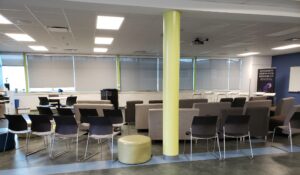 Large classrooms have been created for students to work in teams to solve challenging projects and problems for businesses and organizations in their community. Like a business, they schedule and run meetings with clients and one another, use personal devices to research and complete work, and communicate through digital and in-person methods. Projects are tied to Common Core State Standards, but students are expected to grow and excel in more than just content literacy. As they solve these real-world problems, they’re building agency, reflection, critical thinking, written communication, and presentation skills.
Large classrooms have been created for students to work in teams to solve challenging projects and problems for businesses and organizations in their community. Like a business, they schedule and run meetings with clients and one another, use personal devices to research and complete work, and communicate through digital and in-person methods. Projects are tied to Common Core State Standards, but students are expected to grow and excel in more than just content literacy. As they solve these real-world problems, they’re building agency, reflection, critical thinking, written communication, and presentation skills.
Students earn and build trust through their iCard system. With this trust comes the option to choose teammates and the flexibility to learn in different spaces. One of those is the multipurpose room which has flexible seating and a projector. In addition to students meeting there to work, this space is used for classes, large presentations, lunch, school meetings, and a place to relax before or after school.
NNT courses are 1.5 hours in length to provide ample time to make progress on projects. Because Niles New Tech is project based, subjects are combined to create courses like Health and Marketing and US History and English 9. During the 2021-22 school year, one project students completed in their Health and Marketing class was for the Children’s Advocacy Center (CAC). For Child Abuse Month, students created three Facebook posts that the CAC could use to create more awareness of the issue. For the first post, students researched a child abuse topic and then highlighted the topic in a more positive manner. In a second post, students created an infographic about child abuse, and their third post called on people to take action. Every group presented their three posts to the CAC who then had a compilation of Facebook posts to use for the month.
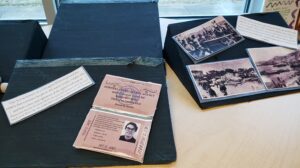 Students often partner with the Fort St. Joseph Museum/Niles History Center and the Niles District Library for projects in their History/ELA class. They have created a Vietnam War play using the Brechtian style of performance and an exhibit for the museum on a particular historic theme. Other projects students completed at NNT are a podcast about genetic mutations, a marble race to raise money for essential workers, an escape room that middle school students had to solve, and a restaurant project where students decided on the type of restaurant, created a mission statement, developed a marketing plan, set a menu, and designed the menu for digital and print.
Students often partner with the Fort St. Joseph Museum/Niles History Center and the Niles District Library for projects in their History/ELA class. They have created a Vietnam War play using the Brechtian style of performance and an exhibit for the museum on a particular historic theme. Other projects students completed at NNT are a podcast about genetic mutations, a marble race to raise money for essential workers, an escape room that middle school students had to solve, and a restaurant project where students decided on the type of restaurant, created a mission statement, developed a marketing plan, set a menu, and designed the menu for digital and print.
In addition to NNT courses, 9th graders take two high school electives and 10th graders take one high school elective. In 11th grade, students take one block at NNT and either dual enroll with Lake Michigan College and Southwestern Michigan College or take career and technical courses, AP courses, or electives within Niles High School. Students enrolled in Niles New Tech like collaborating with different people all day. One student shared that, “it is super engaging and I love to apply my learning to a project with my community partners.”
NNT graduates wear a cord designating New Tech as they walk in the graduation ceremony with other high school students. They also celebrate their NNT specific accomplishments in a ceremony called the “Senior Celebration.” Niles New Tech serves as a national demonstration site for the New Tech Network.
Additional Personalized Learning Options
The non-traditional education programs at Niles are all housed in the Niles Community Schools Administration Building.
Niles Virtual School
Students from kindergarten through 12th grade have the option to enroll in Niles Virtual School (NVS). NVS is an asynchronous virtual program where students progress at their own pace through semester or year-long courses. The program is available to any full-time, home school or private school student who resides in Michigan and who is enrolled in the Niles Community School district. Like all virtual programs in Michigan, students receive a computer and internet access if needed, have a Teacher of Record for each class, and connect with their mentor at least once a week. District curriculum is developed by NVS teachers in Canvas, their learning management system. Courses contain lessons, dig deepers, and mastery sections. Students have the option to demonstrate their learning in different ways like creating, speaking, or test-taking. A log tracking student time spent in the course is also part of the program.
 Core and elective courses are offered through Niles Virtual. Full-time students take core classes through Lincoln Learning (K-5) or Edgenuity (6-12). A wide variety of elective courses are available either from the vendors (Michigan Virtual, eDynamics, Edgenuity, PowerSpeak, Rosetta Stone, APEX, Edmentum), other district building in-person electives, or from the Elective Canvas Course catalog. High schoolers also have the option to personalize their learning with AP, dual enrollment, and CTE courses. Part-time students may enroll in elective courses.
Core and elective courses are offered through Niles Virtual. Full-time students take core classes through Lincoln Learning (K-5) or Edgenuity (6-12). A wide variety of elective courses are available either from the vendors (Michigan Virtual, eDynamics, Edgenuity, PowerSpeak, Rosetta Stone, APEX, Edmentum), other district building in-person electives, or from the Elective Canvas Course catalog. High schoolers also have the option to personalize their learning with AP, dual enrollment, and CTE courses. Part-time students may enroll in elective courses.
Niles Virtual School offers many dual enrollment options. As of March 11, 2021, NVS partnered with 22 colleges and universities. Learners interested in dual enrollment must complete the Dual Enrollment Counseling course in Canvas before classes are approved to increase their success in completing college courses.
Learners taking an Elective Canvas Course through Niles Virtual are required to also take an NVS Connections – Homeroom class. The Homeroom class is for communication purposes to keep everyone on the same page through announcements, access to forms, and other information like testing. Canvas courses may be paired with an Optional Learning Experience.
NVS Optional Learning Experiences are opportunities for students to learn from community experts. These classes range from in-person to 100% virtual. Elective experiences include land and animal, home economics, music, visual and performing arts, physical education, and world languages. Examples of courses include, Safari Hunt, Dance Around the World, Innovative Thinking, and Equine Art – Drawing & Painting.
WAY Programs
Niles began the WAY program in 2011 for students who want to be “in” school where help is available, but not be in the traditional environment. The program meets the needs of students with life circumstances that do not fit a traditional school schedule, who are behind in credits, homeschool students, or anyone who enjoys learning in a creative way. Between 100 and 150 students enroll in the program to catch up or to graduate early. Although in a separate building from the high school, bussing and meals are provided.
In this personalized program, students co-develop standards-based learning plans with their mentor. Within those plans, they complete co-curricular projects that cover the state standards. Students can choose from teacher developed projects, build their own project, or take an existing project and adapt it to more align with their interests. About 90% of students use the projects or adapt them. For example, the English 12 course requires a research essay. The course has been developed to research the Holocaust, but students may choose a different topic for their essay. Popular projects students complete include Eminem as a Poet (ELA course) and Running for President (Civics course). Students also like to beat the teacher in the Oregon Trail History project.
 Students can enroll in and complete classes any time of the year, even throughout the summer. Because the program is virtual, they can work on their classes at any time of the day. The learning management system, Centric School, contains their customized curriculum, tracks their progress in the standards, stores their demonstration of learning, and allows students, teachers, and administrators to easily communicate about their learning. A physical lab is available for students to work in and get help. Students who are off track are required to come into the lab to work. Assistance is also available online from teachers across the state with a math, ELA, and social studies teacher available at all times. Students can schedule a 30-minute, one-on-one Zoom lesson with them or attend a live class that is scheduled on a specific date and time.
Students can enroll in and complete classes any time of the year, even throughout the summer. Because the program is virtual, they can work on their classes at any time of the day. The learning management system, Centric School, contains their customized curriculum, tracks their progress in the standards, stores their demonstration of learning, and allows students, teachers, and administrators to easily communicate about their learning. A physical lab is available for students to work in and get help. Students who are off track are required to come into the lab to work. Assistance is also available online from teachers across the state with a math, ELA, and social studies teacher available at all times. Students can schedule a 30-minute, one-on-one Zoom lesson with them or attend a live class that is scheduled on a specific date and time.
“We build relationships with the student as a person,” shared Andrew Brawley, Director of Niles WAY and WAY Forward. “They want to know that someone is in their corner “
Niles was the first in the state to open a WAY middle school program called WAY Forward. Students choose this program because of the smaller class sizes compared to the traditional middle school. Similar to the traditional environment, they are required to come in every day to work in the WAY middle school lab even though courses are virtual. Unlike the high school WAY program, students in WAY Forward prefer to work on the projects in groups rather than alone.
Cedar Lane – Alternative Education
Cedar Lane Alternative High School enrolls about 50 students in the building and 50 students virtually. This program is attractive for students who are behind in credits and may not be able to graduate high school on time. Focusing on the Michigan Merit Curriculum, students graduate with the Niles High School diploma with 20 credits. Personalized attention is given to each student through direct classroom instruction for core courses and virtual curriculum using Edgenuity for electives. Every student is issued a Chromebook to use while in the building and class sizes average 16 students.
The format is similar to the traditional schedule with seven-hour days in the building. Students may take electives like Spanish, virtual classes, or special programs during the last hour if they are caught up on their work. Bussing, breakfast, and lunch are provided. Students can transition to full-time virtual and back into the building when needed. When online, staff members mentor the students. This back-and-forth option was helpful throughout the pandemic.
The culture at Cedar Lane focuses on attendance, academics, and attitude (behavior). Staff are very attentive to what students are doing. They check if students are passing classes, look at their progress, observe hallway behavior, and talk with students about accountability. One student commented, “they care because they make me do my work.” A counselor is also on staff who meets individually with students, leads depression and anxiety groups, facilitates a girls leadership group, and runs ACEs.
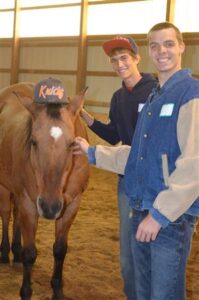
PC: Niles Community Schools website
Cedar Lane offers two special optional learning experiences for students. The National Archery in Schools program is sometimes available in the indoor gym/cafeteria. In this PE course, students learn technical skills like how to hold a bow and release the arrow as well as life skills like focus, self-control, discipline, and patience. Through this process-oriented activity, students are learning to regulate their emotions as they regulate their internal breathing to hit the target.
Another unique opportunity for students attending Cedar Lane is their Reaching for the Reigns program. This program uses service learning to build positive self-image and relationships, provide necessary tools to make a difference in their community, and encourage youth to try new things. To be eligible, students must have good attendance and grades. During the first semester, students visit a horse farm 10 times. They learn how to care for, lead, guide, and groom the horses. They also develop teamwork and leadership skills as well as learn how to reflect on their emotions, behavior, and learning. During the second semester, students spend another nine or ten days using these new skills to mentor special needs students from the Lighthouse Education Center as they use the horses.
Service project options are available for all Cedar Lane students in the spring. They can join groups of businesses to clean up the parks along the river, do landscaping around the building, or provide yard cleanup in the neighborhood surrounding the school.
Niles also offers an Adult Education program for individuals 16 and older. Students enroll in the program due to social anxiety, being expelled from the traditional school, having jobs or kids which makes it difficult for attending school during the day, or because trade unions won’t accept a homeschool diploma. The average age of the approximately 100 students enrolled is mid-20s to 30-years old. All classes are virtual using the Edgenuity curriculum. Students can earn their high school diploma or GED, or take adult basic education courses at home or in the lower level of Niles District Library. Advisors are available for assistance at the library Monday through Thursday from 3:00 to 8:00 p.m. College and career assistance is also available.
Niles Community Schools Mission:
Inspire and prepare all learners through diverse opportunities to challenge the present and enrich the future.
Students have diverse opportunities to chart their learning path at Niles Community Schools. Whether they prefer a more traditional environment, a project based approach to learning, self-directed virtual learning, or schooling with a large support system, students can find their fit here. The personalized options available drive their dynamic learners to succeed in whatever path they choose to take.
Author: Lisa Sitkins, President and CEO, LSS Connections and Consulting, LLC, June 2022
